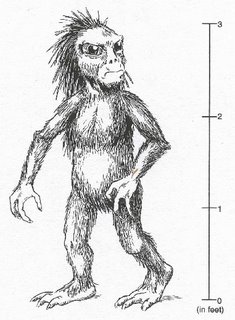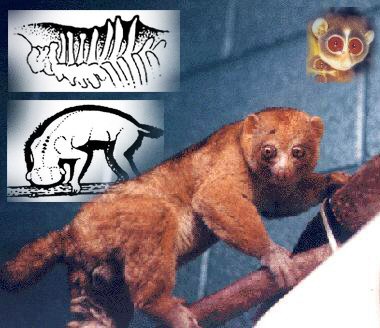
January 14, 2007
The following Cryptomundo Exclusive was posted first on January 13, 2006, and became the most popular blog last year at Cryptomundo. Here’s a quick revisit, for the information is just as intriguing today as it was then. At the end is a new 2007 update, looking at the “spikes” in one known primate species.

Harry Trumbore’s drawing of Africa’s kalanoro, from The Field Guide to Bigfoot and Other Mystery Primates by Loren Coleman and Patrick Huyghe.
I’ve learned, through a confidential source, that at least one unit of the US Navy SEAL (Sea, Air, Land) has had a remarkable recent encounter with unknown apes in Africa. And a video was taken. We are seeking additional confirmation and other eyewitnesses. Have any hints of this story come your way?
Due to the sensitive nature of this former US Navy SEAL’s intelligence-gathering work, at this time we cannot reveal his identity. Hopefully our posting this initial information will develop other sources and confirmations from current and former SEAL members involved, and from interested researchers with hints of the story.
What the former SEAL relates is that he was involved in covert operations in the Democratic Republic of the Congo between 1997 and 2002. According to his account, his team observed a group of thirteen "chimpanzee-like" creatures – as described by the eyewitness – “between 4.5 to 5 feet tall, uniformly gray all over their bodies, with rows of seemingly porcupine-like quills running the length of their backs.”
The unidentified apes walked bipedally and were observed by the SEAL team in the act of killing another animal. When the creatures became excited or agitated, the quills or spines stood erect from their bodies.
According to this informant, the US Navy SEAL team took three minutes of video footage of these creatures, but this tape apparently has been classified, due to their mission. This SEAL member still has his mission maps and is able to pinpoint the area of the encounter with this large group of bipedal apes.
The involvement of a US Navy SEAL team would indicate that their activity employed water as a means of transportation, and/or they were working in an area involving a lake, river, or swamp.
What could these strangely-haired unknown apes be? Their description, overtly, sounds like similar hairy short upright creatures (with bizarre spiked hair) known to inhabit areas near certain bodies of water and from specific islands. Various regional names (chupacabras, kappa) hide the fact they all resemble each other in their number of digits, spiked hair, aggressiveness, and aquatic habits. But let’s just look to Africa alone, today.
Weird rumblings have been heard from the Congo for decades. In Ivan T. Sanderson’s Abominable Snowmen: Legend Come to Life, there is mention of animal collector Charles Cordier finding the small tracks of what the locals called the kakundakari in the Congo in 1961.
I have previously written about an African hominoid that matches the Congolese reports of the Navy SEAL, those of the Madagascar natives’ kalanoro, a short, three-toed, bipedal, water-dwelling, mean, scruffy-hair hominoid.
All the tribes of island of Madagascar, located off the east coast of Africa, know of the Kalanoro, according to folklorist Raymond Decary, who researched the common themes connecting the stories of the Kalanoro back in the 1950s. In 1889, a capture of a Kalanoro was reported to the Royal Geographical Society. In 1924, Chase Salmon Osborn described his sighting of two Kalanoro mating.
The Father of Cryptozoology also took an interest in them. These “legends may be fantastic," wrote Belgium cryptozoologist Bernard Heuvelmans in 1955, but "they are found all over Madagascar, and it would be odd if they were utterly without foundation," especially given the fact that "some areas of Madagascar are still almost unexplored, such as the Ambongo reserve and the lonely Isalo mountains, and there are still some 3 or 4 million hectares of virgin forest…”
The aggressive nature of the Kalanoro comes through in a few accounts, and mirrors the behavior in the SEAL’s account. The Kalanoro are also known to abduct children, and search Madagascar’s villages for food.
How recent are the encounters with these hairy, three-toed Kalanoro with their hooked fingers and aggressive habits? Professor Joe Hobbs of the University of Missouri-Columbia’s Department of Geography, studied them, while he was with the local tribes in the Ankarana Special Reserve, Madagascar, during the late 1990s. On May 15, 2000, when Hobbs wrote his report, he talked of how the people of the village of Ambalakedi consider Andoboara Cave “sacred because on three separate occasions, most recently just two years ago, grief-stricken parents whose children had wandered into the forest had recovered them alive here" after food was left out for the Kalanoro in exchange for their children’s return.
If the US Navy SEAL report is correct, there may be something quite similar to the Kalanoro living in the Congo area too.
And if the Congo SEAL encounter was so very extraordinary, others may have talked about, it in passing. Since this "unknown hominoid" piece of the mission does not involve national security, but may extend cryptozoological knowledge, it is time to learn more, release the video footage, and analyze what was seen.
Do you have further information on this US Navy report? Please send what you’ve heard our way, via the comments’ section or let us know you want further contact through back channels.
^^^^^^^^^^^
UPDATE 2007 – Those spikes…
There is a primate named the potto, which is a central African loris, that does have spikes that comes through it’s neck and upper back skin/fur, from its spine. The spikes stand up when the potto is threatened by a predator, so the attacker cannot bite the potto on the neck. So much for there not being any known primates with spikes.
Three of the vertebrae in the Potto’s neck have sharp points and nearly pierce the skin; these are used as defensive weapons.

As Alton Higgins has commented, Desmond Morris describes these “spines” on page 124 in The Mammals: A Guide to the Living Species (1965):
The most outstanding physical characteristic of this animal is the row of horny tubercles which cover the elongated spines of the last cervical and the first tow thoracic vertebrae. These spikes protrude through the skin of the back of the neck and are used in self-defense, the Potto curling itself up and flinging this region at its attacker’s face. The animal seems to have special control of the hair tracts on either side of these tubercles, the fur being actively parted to lay them bare.
The example of the potto is merely to demonstrate that “spike”-like structures have been seen on primates. Nature’s designs are rather amazing. (I have never described the Kalanoro’s or the potto’s spikes as “porcupine-like”; that was a descriptor used by the eyewitness. Indeed, the Kalanoro’s spikes could be merely hair sticking up.)
As was quoted above, it is in the zoological literature that the potto’s little spikes from the vertebra came through the skins. This observation was reinforced in comments by zoologist Ivan T. Sanderson who also saw them coming through the skin on the ones he handled and examined on his animal collecting expeditions to Africa.
About Loren Coleman
Loren Coleman is one of the world’s leading cryptozoologists, some say “the” leading living cryptozoologist. Certainly, he is acknowledged as the current living American researcher and writer who has most popularized cryptozoology in the late 20th and early 21st centuries.
Starting his fieldwork and investigations in 1960, after traveling and trekking extensively in pursuit of cryptozoological mysteries, Coleman began writing to share his experiences in 1969. An honorary member of Ivan T. Sanderson’s Society for the Investigation of the Unexplained in the 1970s, Coleman has been bestowed with similar honorary memberships of the North Idaho College Cryptozoology Club in 1983, and in subsequent years, that of the British Columbia Scientific Cryptozoology Club, CryptoSafari International, and other international organizations. He was also a Life Member and Benefactor of the International Society of Cryptozoology (now-defunct).
Loren Coleman’s daily blog, as a member of the Cryptomundo Team, served as an ongoing avenue of communication for the ever-growing body of cryptozoo news from 2005 through 2013. He returned as an infrequent contributor beginning Halloween week of 2015.
Coleman is the founder in 2003, and current director of the International Cryptozoology Museum in Portland, Maine.
Filed under Breaking News, Cryptomundo Exclusive, CryptoZoo News, Cryptozoology, Eyewitness Accounts